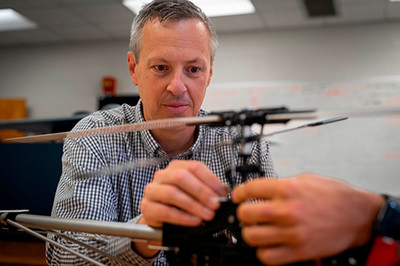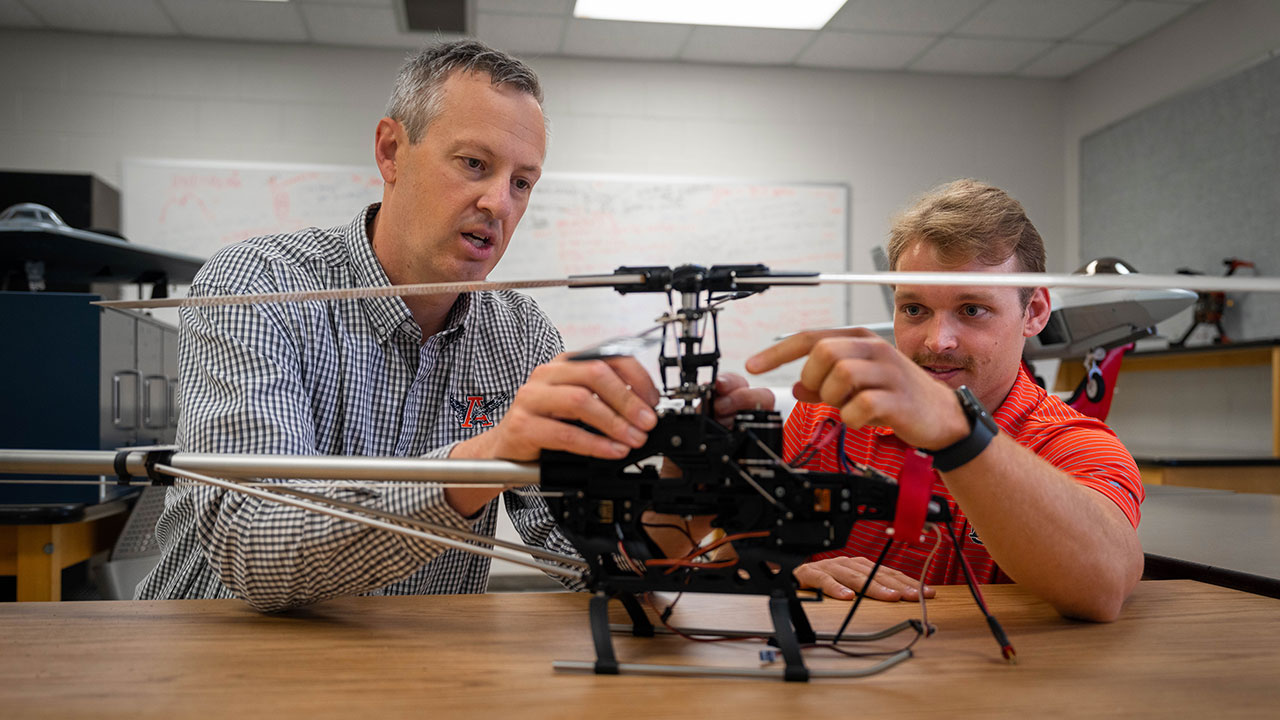Can a helicopter safely land after engine failure? Researcher in ECE earns $307K grant to explore how
Published: Jun 27, 2024 1:10 PM
By Joe McAdory
Turbine helicopter engines fail once every 375,000 flight hours according to the Federal Aviation Administration. Which control sequences and flight conditions make it possible for trained pilots to land in the event of engine failure? Which conditions do not?
Matthew Kirchner, assistant professor in electrical and computer engineering, will soon find out.
Sponsored by the Office of Naval Research, his three-year, $307,000 study, “Safe Flight Envelope Characterization and Emergency Landing with Reachability,” will create height-velocity diagrams (H-V diagrams) for various helicopter models — guides for pilots to handle emergency landings and investigate reliable engine failure detection techniques.

“It’s rewarding to have the opportunity to provide the Navy with important information that could reduce the number of potential accidents and keep our pilots safe,” said Kirchner, who spent 16-plus years as a research scientist at the Naval Air Warfare Weapons Division in China Lake, California, before joining the faculty at Auburn University this past fall.
Kirchner’s research will distinguish “safe regions” from “unsafe regions” when pilots undergo emergency landings. Safe regions are defined as “any initial flight condition where there exists a control sequence that can steer the system (manned or unmanned) to a safe landing condition.” Unsafe regions are conditions where no such control sequence is available and a safe landing is impossible.
Engine failure doesn’t immediately lead to rotor failure. Like a common ceiling fan, momentum allows blades to spin for a short time after power failure. Kirchner referred to this phenomenon as “autorotation.”
Kirchner will create control sequences via H-V diagrams to initiate an autorotation, whereby the helicopter enters a glide slope to maintain rotor inertia before safely touching down.
“The pilot can still move the helicopter forward based on inertia and the angular momentum of the blades,” said Kirchner, whose research also applies to unmanned rotorcraft. “Helicopters can change the pitch of the blades as they’re spinning. When there is no engine power at all, one must be careful. If you have too much pitch, the pilot might delay the sink rate but will also eat up much of that angular momentum.
“You’re falling, but if you do it the right way, you can keep the blade spinning and could have enough energy left over to flare the helicopter and touch the ground safely. Pilots must find that sweet spot. If you lose energy at some point… you’re toast.”
Kirchner will utilize scaled radio-controlled rotorcraft on test fields near Auburn University and the Manned Flight Simulator Facilty – a high-fidelity, man-in-the-loop research/development test and evaluation flight simulation laboratory at the Naval Air Warfare Center Aircraft Division in Patuxent River, Maryland.
“H-V diagrams are ultimately determined through flight testing, which is inherently dangerous since the test objective is to define the unsafe boundaries of flight operations,” Kirchner said. “Therefore, there is a need to accurately compute the safe and unsafe regions directly from the helicopter dynamics and construct a H-V diagram prior to flight testing.
“The Navy needs to have information it can give to pilots that says, ‘we might have a safer region over here,’ or ‘it’s best to minimize another region over there. We must update pilots in real time to know where they can account for these factors and be able to tell them precisely how they can execute specific maneuvers.”
Kirchner is joined on the project by Jacques Hoffler, Eddie Ball and Donald Gaublomme from the Naval Air Warfare Center Aircraft Division’s Flight Vehicle Modeling and Simulation Branch.
Media Contact: , jem0040@auburn.edu, 334.844.3447
Matthew Kirchner, assistant professor in electrical and computer engineering, and graduate student Sean Bowerfind prepare a radio-controlled helicopter for testing.


